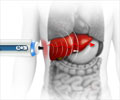
‘New scoring system helps predict risk of death from non-alcoholic fatty liver disease (NAFLD), NAFLD is the world's most prevalent liver disease.’
Tweet it Now
The researchers used data from 139 patients with biopsy-proven NAFLD. All of the biopsies were re-classified according to the SAF scoring system, with the diseases defined as mild, moderate or severe via an index combining activity and fibrosis. Further data on overall mortality was taken from a national population register. A Cox regression model, adjusted to take into account body mass index and the presence of type 2 diabetes, was used to examine the predictive value of the SAF score. Patients were followed up for an average of 26 years (standard deviation 6.1, range 1.7 - 40.8 years). At baseline, 69 patients had a severe form of the disease and 35 patients had mild or moderate disease. Of the 70 patients who died during follow-up, 59% came from those previously classified as having a severe form of NAFLD.
"This long-term study demonstrates the importance of having sufficient follow-up periods for patients with NAFLD," said Professor Laurent Castera, EASL Secretary General. "This is an important step forward for the medical community in being able to identify the patients who are at most risk of death from the disease."
Source-Eurekalert














